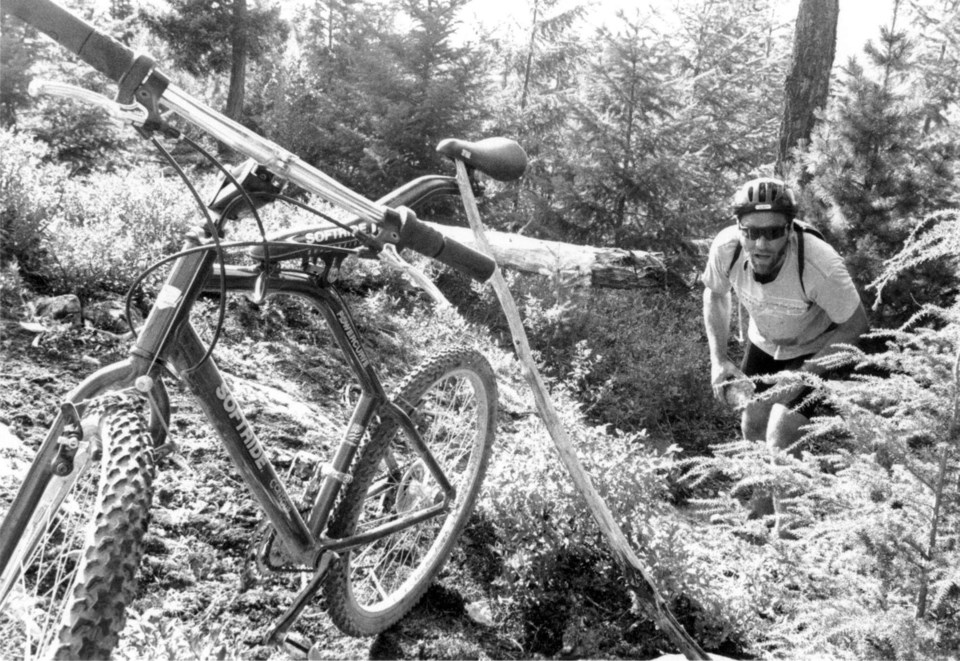Nancy Wilhelm-Morden made many important decisions for the Whistler community during her time as councillor and mayor. However, one of the accomplishments she is most proud of from this time is the protection of the Emerald Forest.
Emerald Forest is the 56.3-hectare (139-acre) protected area between Whistler Cay and Alpine. It is a significant habitat corridor for many of Whistler’s furry and feathered friends, and is also enjoyed by hikers and bikers.
Before 1972, when the BC Highways Department extended Alta Lake Road connecting Rainbow Lodge (now Rainbow Park) to Alpine, there was limited access to the area now known as the Emerald Forest. The extension of Alta Lake Road, along with the construction of the first section of the Valley Trail between Whistler Cay and Alpine, meant that the Emerald Forest Lands became more readily accessible to recreationists.
When mountain biking took off in the 1980s, the local trailbuilders started what are today Whistler’s world-renowned mountain bike trails. Many of the earliest trails were built through the Emerald Forest, despite it being privately owned land.
The lot had been bought by Decigon Corporation in the late 1970s. As the area became more popular with mountain bikes, “no trespassing” signs started to appear. There were additional challenges, as well, when a mountain biker broke their back in the early 1990s and brought a lawsuit against the landowners.
Decigon made multiple unsuccessful attempts at getting the land rezoned throughout the late 1980s and early 1990s. Then, in 1996, the municipality increased the minimum parcel size of land with the Rural Resource 1 Zoning (RR1) from 20 acres to 100 acres. This meant that parcels zoned RR1 could be subdivided into 100 acres at minimum. Trying to maximize its return on investment, Decigon came forward with proposals to develop the land before this change came into effect.
The company’s preferred plan was for high-density development on a small section of the land. Forty single-family lots with a total of 240 bed units were proposed for 20 acres. Under this plan, the remaining undeveloped land would be protected as parkland, therefore retaining many of the bike trails. This would require rezoning of the land, and the municipality was reluctant to approve the proposal because the number of bed units exceeded the development cap.
Decigon’s alternative proposal involved subdividing the entire lot into 20-acre parcels for six single-family homes with 36 bed units. This fit within the RR1 zoning restrictions, but would result in a huge loss of established biking trails. Local community groups the Association of Whistler Area Residents for the Environment (AWARE) and the Whistler Off Road Cycling Association (WORCA) were also very active in campaigning for the protection of the forest for the environment and recreation.
Between 1996 and 1999, Decigon, led by the Houghton brothers, was constantly in the media trying to garner support from the Whistler community and council. However, they could not come to an acceptable agreement with the council of the day, and Decigon became more and more outraged as the years passed. Most meetings were held in-camera—meaning closed to the public—and rumours were swirling about an impending lawsuit against the municipality.
Then, in August 1999, it was finally announced that a deal had been made for the Emerald Forest lands. Unbeknownst to the community, Intrawest had been brought in as a third party to finally make the deal happen. In the three-way deal, Intrawest purchased the Emerald Forest lands from Decigon for an undisclosed sum. The municipality then paid Intrawest $1 million, and gave it approval for an additional 476 bed units so it could develop two further hotels in the Benchlands, in exchange for the Emerald Forest.
There was some disappointment toward this agreement, because it meant that Whistler would far exceed the development cap outlined in the Official Community Plan. However, the unique agreement succeeded in ensuring the Emerald Forest was protected in perpetuity.




